Salting - Drying - Curing - Smoking - Maturation of meat.I am writing this page in English with Google translator. Click the Danish version and see the original Danish website.
This English page is suitable for PC - Tablet - Mobile phone. |
|
Procedure for vacuum salting of meat
Danish version Next Down |
|
The page you are coming from has calculated the amount of common salt, nitrite salt and sugar for the amount of meat you have entered. The degree of salting is constant 2.4% and the nitrite content per kg of meat is 102 mg. It is a prerequisite that you use Danish nitrite salt of 0.6% nitrite. If you buy nitrite salt in Germany the mixture is 0.4% to 0.5%, The same goes for Chrisale salt from Austria. It just means the nitrite content gets a little smaller. It is regulated as follows:
At 17 g nitrite salt of 0.6%, the nitrite content is 102 mg/kg meat. Ordinary salt 7 g. The degree of salting is constant 2.4% when the total amount of salt is 24 g per kg of meat. At 20 g nitrite salt of 0.5%, the nitrite content is 100 mg/kg meat. Ordinary salt 4 g. The degree of salting is constant 2.4% when the total amount of salt is 24 g per kg of meat. At 24 g nitrite salt of 0.4%, the nitrite content is 96 mg/kg meat. Common salt 0 g. The degree of salting is constant 2.4% when the total amount of salt is 24 g per kg of meat. The reason for adding Nitrite is to extend the shelf life of the meat and that the meat does not spoil and you get sick from eating it. It can lead to Botulism - Sausage poisoning. Another benefit is also that the meat remains more red and looks more appetizing than the gray color that meat would otherwise get when it is oxygenated. There must only be the absolutely necessary nitrite content in our food, which is necessary for a good preservation and thus provide food safety. Below are some products and the allowable amounts of Sodium Nitrite in mg per kg of meat. Permitted amounts of Nitrite total added in production per kg of meat 1. 100 mg/kg for sterilized meat products. I assume that these are cooked products (Sausages for example) 2. 150 mg/kg for most meat products. 3. 180 mg/kg for meat from Member States. If you add nitrite salt to your food, it may be advisable to add ½ grams Sodium ascorbate E301 per kg of meat. It is a salt of Ascorbic acid E300 which is an antioxidant. It is used in many foods. The purpose here is to keep the red color in the meat for a longer time, as well as to reduce the residual content of nitrite with time. It is optional to add Sodium Ascorbate E301. It is expensive in Denmark, but can be purchased on this German website: Sodium Ascorbate Powder for 19.00 EUR incl. shipping to Denmark. Fast delivery only 5 days. Permitted maximum residual amount of Nitrite total at the end of production 1. 50 mg/kg These 3 values apply to certain imports of products. 2. 100 mg/kg meat products from the EU and England? 3. 175 mg / kg mainly bacon, ham, ham and dry cured meat. Read Meat Lover's article "Nitrite salt - why now that?" Good reading material to familiarize yourself with the cases. Vacuum saltingThe meat must be weighed before it is salted and after it has been smoked and matured, the values are noted down. The shrinkage is calculated and the result must be between 25% and 30%.The measured amount of salt, sugar and any spices are mixed well and rubbed into the meat. Put the meat in a vacuum bag and make sure to get the whole salt mixture into the bag otherwise the values will not hold. My experience says that you should take ½ g more common salt and ½ g nitrite salt, ie 25 g total salt for 1000 g meat. 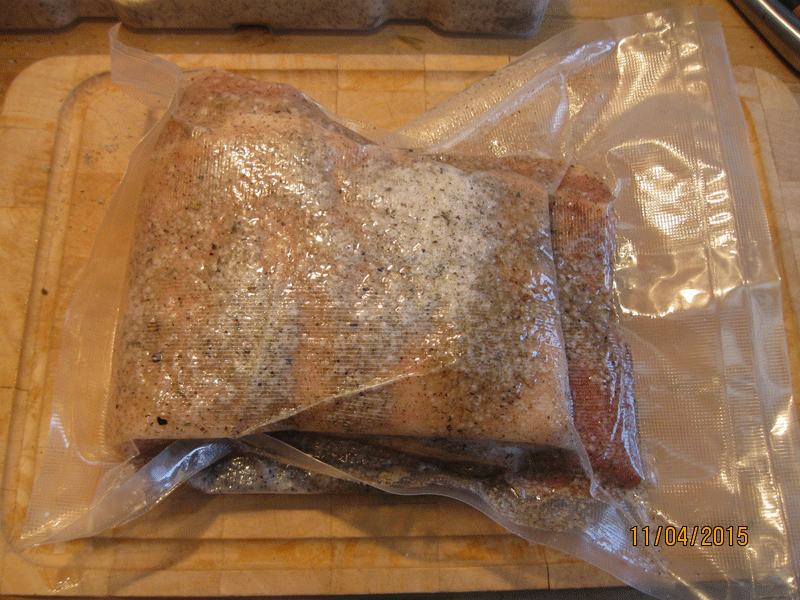
The meat is salted with spices and ready for the fridge. 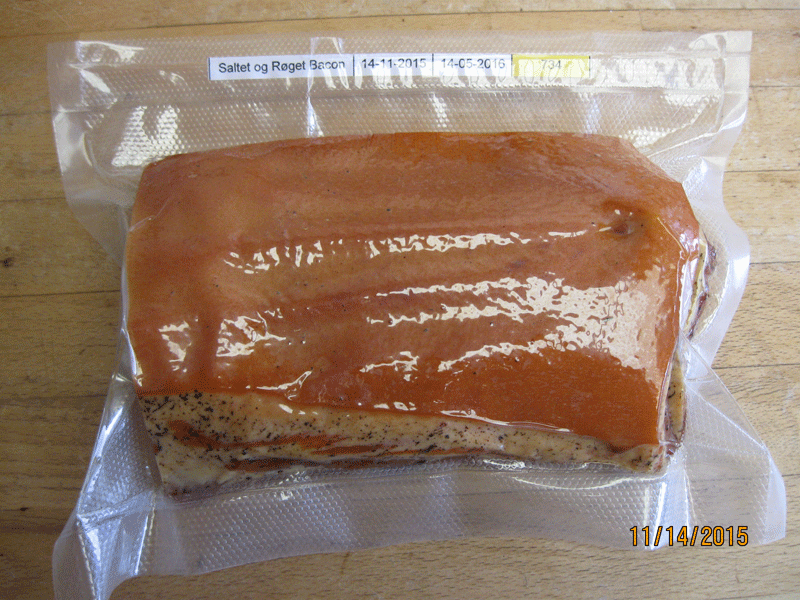
The meat is smoked and ready for ripening in the fridge. The salting timePlace the vacuum bag in the refrigerator at 5°C to 7°C and invert once a day. The time is calculated according to this rule: Measure the height of the bag and for every 1 cm calculate 3 days if it is pork with rind. If it is without rind, calculate 2 days per 1 cm. However, at least 1 week for each. If you use this salting method, you are sure to get a uniform salting and you do not get an oversalting of the meat. When the meat has been salted, it is placed in cold water for 30 to 60 minutes to rinse off the surface salt, stop the salting process and soften the meat.Drying and curing timeThe meat must then be dried and hardened in the refrigerator at the same temperatures as above. The time will depend on the thickness of the meat, 3 to 7 days will be normal for large pieces of meat.One must pay attention to the humidity in the refrigerator. It must not be too high. RH 20% to RH 30% will be OK. Buy a thermometer with built-in humidity meter online: Wish in China. 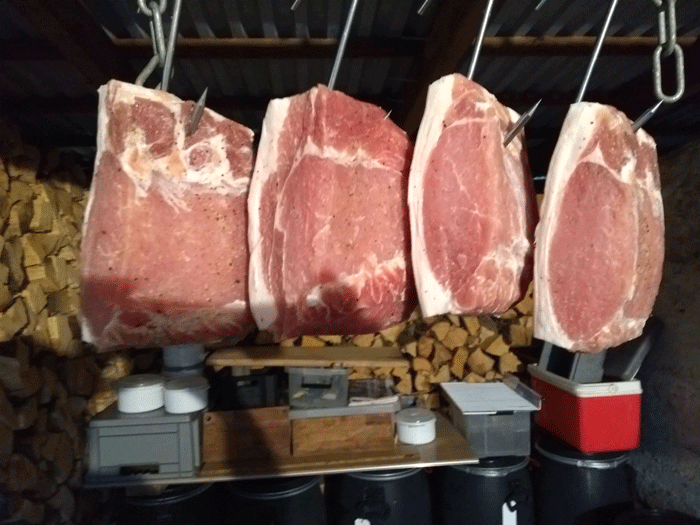
4 pieces. roast pork for drying before being cold smoked. 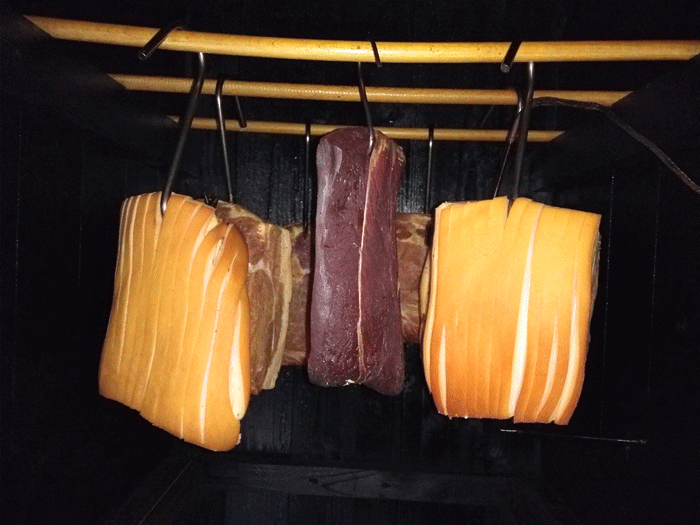
Here they hang for smoke, along with other meat. But not finished yet. Cold smokingThen comes the time when the meat is to be smoked. It is normal to cold smoke his meat: Bacon - Ham - Basturma - Pancetta - Ribs rose. Max. temperature for cold smoke is 27°C, but Min. temperature there are not many talking about. My experience says that the temperature should be above 10°C and preferably up to 18°C so that the cold water vapors do not condense around the smoke particles and thus give acid smoke. In addition, there must be good draft through the smoke oven so that there is no stagnant smoke, it also gives acid smoke. The smoke coming out of the chimney must be white. If all this is fulfilled, you get a good result.It is good to interval smoke. You smoke your meat for 3 to 5 nights, take a break during the day. My maze/spiral tray can smoke for 14 to 20 hours when filled with 2 liters of smoke flour. Slightly depending on how much the wind is blowing. On the page Smoke dust you can find an overview of smoke dust for Cold smoking and Hot smoking. If you can not achieve the correct temperature in the cold winter nights, you can turn on your maze/spiral tray at both ends, then the temperature will rise a few degrees. Otherwise you have to get a heater, as I have done. Alternatively a 60 W lamp, but both parts are mounted under the maze/spiral tray. So maybe the tray needs to be raised from the bottom. 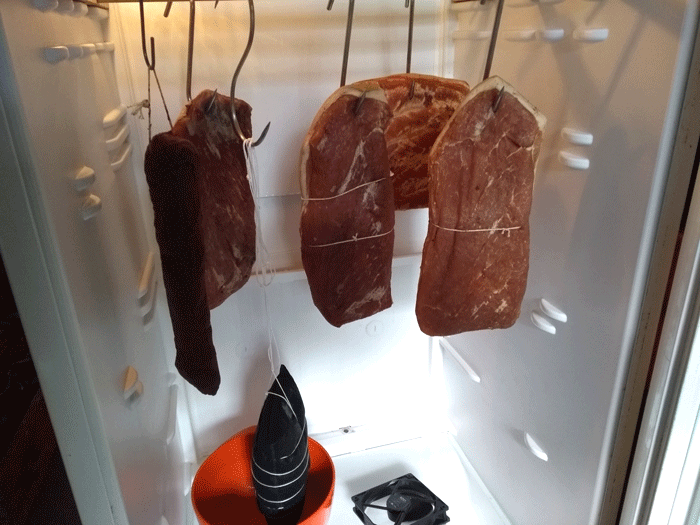
3 pieces. hams for maturation in the refrigerator. 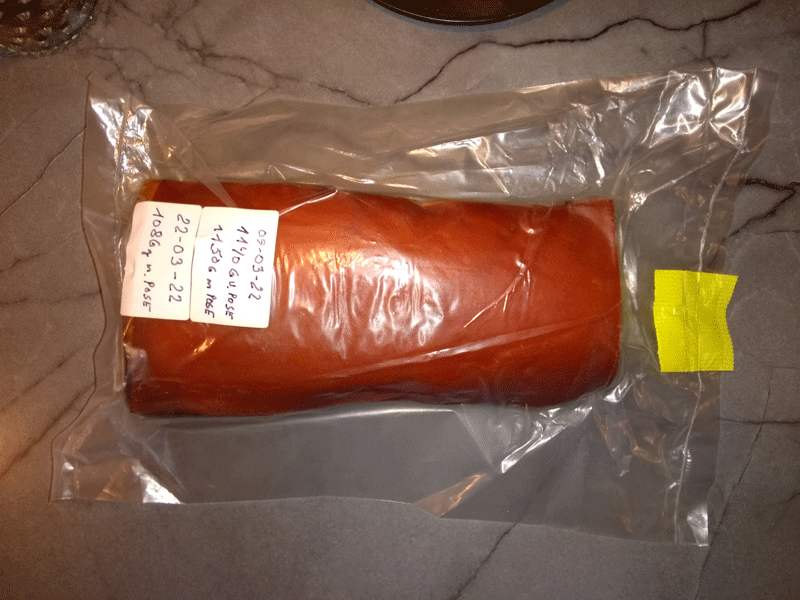
1 piece. ham for maturation in Dry Aging Bags. Then comes in the fridge. Maturation of the meatDepending on what you have smoked, a maturation time of 21 to 28 days will be a good starting point. For this you need a refrigerator that maintains a temperature of 4°C around the clock and a humidity RH of 20 %.Not: Do not confuse the maturation of smoked, finished products with the maturation of fresh meat. Here the optimum temperature is 1°C to 3°C around the clock and a humidity RH of 80 %. Then the meat can last the longest and the juice from the meat does not evaporate too quickly. When you ripen a ham in the fridge - or some other meat - it is important that it hangs up in the fridge with some air around it. The meat must not get direct drafts, because then it will get a crust of dryness where the air affects the meat. Another important thing is to weigh the meat. It is mentioned above that the shrinkage should be between 25 % and 30 % to give max. durability. My last ham had lost 28 %, which was very satisfying. In the picture above, the 3 hams are seen hanging freely in the fridge. There is also a pork tenderloin and a rib roast. The black bag above the bowl is 1 kg of silica gel, which absorbs water vapor and thus reduces the humidity in the refrigerator. However, it is a condition that the refrigerator is not opened too often in humid environments. The black "gizmo" at the bottom is a PC FAN, which provides less circulation in the refrigerator. After a few weeks in the fridge, one ham came in a Dry Aging Bag. It weighed 1150 grams when it was put in the bag and 13 days later I took it out and weighed it to 1086 grams. In 13 days it had lost 64 grams. I'm very impressed, it works. Just a shame that those bags are so expensive. Maybe one should try looking online for better prices: Wish in China. You may know the breathable clothing Gore-Tex. It's the same way the bags work. There is a special membrane which allows water vapors to penetrate through this membrane but not in from the other side. This means that bacteria and other "dirt" cannot enter the meat in the bag. Gore-Tex here you can read more about the product. Vacuum salting of meat and a fixed salt calculation of 2.4% Vacuum salting of meat and gourmet salt calculation Meat, salt, nitrite and sugar calculator Calculation of mg nitrite per kg of meat with 0.6% nitrite salt Calculation of mg nitrite per kg of meat with 0.4% nitrite salt Nitrite calculates with different nitrite salt strength Calculation of degree of salting in % in meat Postscript: Here is some information on salting foods. There are several - four - methods to salt your food. Wet salting - here the food comes in a brine of water and salt. Used for large fish and many fish at once. Always to eel. The advantage of this type of salting is that it becomes a uniform salting throughout the fish. Dry salting - here the food is covered with plenty of salt and hung up so that the liquid can drip off. Often used for flatfish, which afterwards must be smoked for "Bakskuld", or simply "Salted Frederikshavner". Dry salting in your own brine - The first method is vacuum salting. 2nd method is barrel salting. The same for both methods is that the food releases so much liquid that it ends up in its own brine. Vacuum salting is only for small portions and barrel salting is for very large portions. Think of herring in 100 liter barrels. Needle salting - here a syringe with a meat cannula is used to inject saline with any spice flavor. Available online "Dick Handle Spray" for DKK 1,130.00. Used a lot for "Hamburger backs", or other pork meat. |
Back to the page where you came from.

one.com |